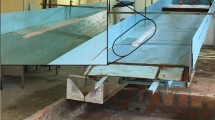Abstract
Roadheading machines play a vital role in excavation operation in tunneling and mining industries notably when selective mining is required. Roadheaders are more effective in soft to medium rock formations due to a higher cutting rate in such strata. A precise prediction of machine’s performance is a crucial issue, as it has considerable effects on excavation planning, project’s cost estimation, machine specification selection as well as safety of the project. In this research, a database of machine performance and some geomechanical parameters of rock formations from Tabas coal mine project, the largest and fully mechanized coal mine in Iran, has been established, including instantaneous cutting rate (ICR), uniaxial compressive strength, Brazilian tensile strength, rock quality designation, influence of discontinuity orientation (Alpha angle) and specific energy. Afterward, the parameters were analyzed through genetic programming (GP) and gene expression programming (GEP) approaches to yield more accurate models to predict the performance of roadheaders. As statistical indices, coefficient of determination, root mean square error and variance account were used to evaluate the efficiency of the developed models. According to the obtained results, it was observed that developed models can effectively be implemented for prediction of roadheader performance. Moreover, it was concluded that performance of the GEP model is better than the GP model. A high conformity was observed between predicted and measured roadheader ICR for GEP model.










Similar content being viewed by others
References
Armaghani DJ, Hajihassani M, Marto A, Faradonbeh RS, Mohamad ET (2015) Prediction of blast-induced air overpressure: a hybrid AI-based predictive model. Environ Monit Assess 187:1–13
Armaghani DJ, Faradonbeh RS, Rezaei H, Rashid ASA, Amnieh HB (2016) Settlement prediction of the rock-socketed piles through a new technique based on gene expression programming. Neural Comput Appl. doi:10.1007/s00521-016-2618-8
Avunduk E, Tumac D, Atalay AK (2014) Prediction of roadheader performance by artificial neural network. Int J Tunn Undergr Space Technol 44:3–9
Baykasoglu A, Gullu H, Canakci H, Ozbakır L (2008) Prediction of compressive and tensile strength of limestone via genetic programming. Expert Syst Appl 35:111–123
Bilgin N, Seyrek T, Erdinc E, Shahriar K (1990) Roadheaders clean valuable tips for Istanbul Metro. Tunn Tunn 22:29–32
Bilgin N, Dincer T, Copur H, Erdogan M (2004) Some geological and geotechnical factors affecting the performance of a roadheader in an inclined tunnel. Int J Tunn Undergr Space Technol 19:629–636
Brownlee J (2011) Clever algorithms: nature-inspired programming recipes. Lulu, USA
Canakcı H, Baykasoğlu A, Güllü H (2009) Prediction of compressive and tensile strength of Gaziantep basalts via neural networks and gene expression programming. Neural Comput Appl 18:1031–1041
Copur H, Ozdemir L, Rostami J (1998) Roadheader applications in mining and tunneling. Min Eng 50:38–42
Cramer NL (1985) A representation for the adaptive generation of simple sequential programs. In: Proceedings of the international conference on genetic algorithms and their applications. Carnegie-Mellon University, Pittsburgh, PA, pp 183–187
Davis JC (2002) Statistics and data analysis in geology, 3rd edn. Wiley, Hoboken
Douglas W (1985) Roadheaders open new horizons at San Manuel. Eng Min J 186:22–25
Ebrahimabadi A (2010) A model to predict the performance of roadheaders in tunneling. Ph.D. dissertation Azad University, Science and Research Branch, Tehran, Iran
Ebrahimabadi A, Goshtasbi K, Shahriar K, Seifabad MC (2011a) A model to predict the performance of roadheaders based on rock mass brittleness index. J S Afr Inst Min Metall 111:355–364
Ebrahimabadi A, Goshtasbi K, Shahriar K, Seifabad MC (2011b) Predictive models for roadheaders’ cutting performance in coal measure rocks. Yerbilim Derg 32:89–104
Ebrahimabadi A, Azimipour M, Bahreini A (2015) Prediction of roadheaders’ performance using artificial network approaches (MLP and KOSFEM). J Rock Mech Geotech Eng 7:573–583
Faradonbeh RS, Monjezi M (2017) Prediction and minimization of blast-induced ground vibration using two robust meta-heuristic algorithms. Eng Comput. doi:10.1007/s00366-017-0501-6
Faradonbeh RS, Monjezi M, Armaghani DJ (2016a) Genetic programing and non-linear multiple regression techniques to predict backbreak in blasting operation. Eng Comput 32(1):123–133
Faradonbeh RS, Armaghani DJ, Monjezi M (2016b) Development of a new model for predicting flyrock distance in quarry blasting: a genetic programming technique. Bull Eng Geol Environ 75(3):993–1006
Faradonbeh RS, Armaghani DJ, Monjezi M, Mohamad ET (2016c) Genetic programming and gene expression programming for flyrock assessment due to mine blasting. Int J Rock Mech Min Sci 88:254–264
Faradonbeh RS, Armaghani DJ, Amnieh HB, Mohamad ET (2016d) Prediction and minimization of blast-induced flyrock using gene expression programming and firefly algorithm. Neural Comput Appl. doi:10.1007/s00521-016-2537-8
Ferreira C (2001) Gene expression programming: a new adaptive algorithm for solving problems. Complex Syst 13(2):87–129
Ferreira C (2006) Gene expression programming: mathematical modeling by an artificial intelligence, 2nd edn. Springer, Germany
Gehring KH (1989) A cutting comparison. Tunn Tunn 21(11):27–30
GEPSOFT (2006) GeneXproTools. Version 4.0. http://www.gepsoft.com/
Ghasemi E, Yagiz S, Ataei M (2014) Predicting penetration rate of hard rock tunnel boring machine using fuzzy logic. Bull Eng Geol Environ 73:23–35
Gholamnejad J, Tayarani N (2010) Application of artificial neural networks to the prediction of tunnel boring machine penetration rate. Min Sci Technol (China) 20(5):727–733
Ghotbi Ravandi E, Rahmannejad R, Feili Monfared AE, Ghotbi Ravandi E (2013) Application of numerical modeling and genetic programming to estimate rock mass modulus of deformation. Int J Min Sci Technol 23(5):733–737
Grima M, Bruines PA, Verhoef PN (2000) Modeling tunnel boring machine performance by neuro-fuzzy method. Int J Tunn Undergr Space Technol 15(3):259–269
Güllü H (2012) Prediction of peak ground acceleration by genetic expression programming and regression: a comparison using likelihood-based measure. Eng Geol 141:92–113
Hoseinian FS, Faradonbeh RS, Abdollahzadeh A, Rezai B, Soltani-Mohammadi S (2017) Semi-autogenous mill power model development using gene expression programming. Powder Technol 308:61–69
Karakus M (2011) Function identification for the intrinsic strength and elastic properties of granitic rocks via genetic programming (GP). Comput Geosci 37(9):1318–1323
Kayadelen C (2011) Soil liquefaction modeling by genetic expression programming and neuro-fuzzy. Expert Syst Appl 38:4080–4087
Khandelwal M, Armaghani DJ, Faradonbeh RS, Ranjith PG, Ghoraba S (2016) A new model based on gene expression programming to estimate air flow in a single rock joint. Environ Earth Sci 75(9):1–13
Khandelwal M, Faradonbeh RS, Monjezi M, Armaghani DJ, Bin Abd Majid MZ, Yagiz S (2017) Function development for appraising brittleness of intact rocks using genetic programming and non-linear multiple regression models. Engineering with Computers 33(1):13–21
Koza JR (1992) Genetic programming: on the programming of computers by means of natural selection. MIT Press, Cambridge
Mahdevari S, Shahriar K, Yagiz S, Akbarpour Shirazi M (2014) A support vector regression model for predicting tunnel boring machine penetration rates. Int J Rock Mech Min Sci 72:214–229
Mollahasani A, Alavi AH, Gandomi AH (2011) Empirical modeling of plate load test moduli of soil via gene expression programming. Comput Geotech 38(2):281–286
Monjezi M, Baghestani M, Faradonbeh RS, Saghand MP, Armaghani DJ (2016) Modification and prediction of blast-induced ground vibrations based on both empirical and computational techniques. Eng Comput 32(4):717–728
Mousavi SM, Aminian P, Gandomi AH, Alavi AH, Bolandi H (2012) A new predictive model for compressive strength of HPC using gene expression programming. Adv Eng Softw 45:105–114
Nelson M, Illingworth WT (1990) A practical guide to neural nets. Addison-Wesley, Reading
Ocak I, Bilgin N (2010) Comparative studies on the performance of a roadheader, impact hammer and drilling and blasting method in the excavation of metro station tunnels in Istanbul. Int J Tunn Undergr Space Technol 25:181–187
Ozbek A, Unsal M, Dikec A (2013) Estimating uniaxial compressive strength of rocks using genetic expression programming. J Rock Mech Geotech Eng 5(4):325–329
Rostami J, Ozdemir L, Neil DM (1994) Performance prediction: a key issue in mechanical hard rock mining. Min Eng 46(11):1263–1267
Saghatforoush A, Monjezi M, Faradonbeh RS, Armaghani DJ (2015) Combination of neural network and ant colony optimization algorithms for prediction and optimization of fly rock and back-break induced by blasting. Eng Comput 32(2):255–266
Sandbak LA (1985) Roadheader drift excavation and geomechanical rock classification at San Manuel, Arizona. In: Proceedings of the rapid excavation and tunnelling conference. New York, pp 902–916
Silva S, Almeida J (2003) Dynamic maximum tree depth—a simple technique for avoiding bloat in tree-based GP. In: Cantu-Paz E, Foster JA, Deb K (eds) Proceedings of the GECC0. Springer, Berlin, pp 1776–1787
Steeb WH (2011) The nonlinear workbook: chaos, fractals, cellular automata, neural networks, genetic algorithms, gene expression programming, support vector machine, wavelets, hidden Markov models, fuzzy logic with C++, Java and Symbolic C++ programs, 3rd edn. World Scientific, Singapore
Teodorescu L, Sherwood D (2008) High energy physics event selection with gene expression programming. Comput Phys Commun 178:409–419
Thuro K (1996) Drillability in coventional drill and blast tunnelling: geological and rock mechanical investigations on seven tunnel project. Munch Geol Hefte Reihe B Angew Geol B1:1–145
Thuro K, Plinninger R (1999) Road-header excavation performance- geological and geotechnical influences. In: 9th ISRM congress Paris, August 25th–28th. Theme 3: rock dynamics and teconophysics/rock cutting and drilling
Tumac D, Bilgin N, Feridunoglu C, Ergin H (2007) Estimation of rock cuttability from shore hardness and compressive strength properties. Rock Mech Rock Eng 40(5):477–490
Yang Y, Li X, Gao L, Shao X (2013) A new approach for predicting and collaborative evaluating the cutting force in face milling based on gene expression programming. J Netw Comput Appl 36(6):1540–1550
Author information
Authors and Affiliations
Corresponding author
Rights and permissions
About this article
Cite this article
Shirani Faradonbeh, R., Salimi, A., Monjezi, M. et al. Roadheader performance prediction using genetic programming (GP) and gene expression programming (GEP) techniques. Environ Earth Sci 76, 584 (2017). https://doi.org/10.1007/s12665-017-6920-2
Received:
Accepted:
Published:
DOI: https://doi.org/10.1007/s12665-017-6920-2




